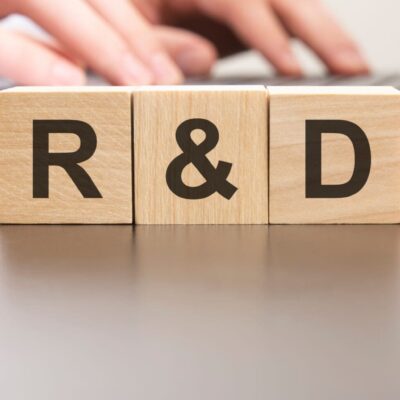Certain pieces of legislation passed by the United States Congress are more well-known than others. For example, most Americans have heard of the Affordable Care Act (ACA), which increases health insurance coverage for the uninsured and implements reforms to the health insurance market.
A majority of U.S. residents probably do not know about the Protecting Americans from Tax Hikes (PATH) Act that was passed in 2015. PATH expanded or renewed several tax credits for individuals, families and businesses. A lesser-known provision of PATH is the permanent extension of the Research and Development (R&D) tax credit.
First introduced in 1981, the R&D credit was enacted as a temporary tax incentive under Section 41 of the Internal Revenue Code (IRC) to assist businesses in investing in new technology. Before the PATH Act, the R&D tax credit underwent several short-term legislative adjustments and extensions.
What exactly does the R&D tax credit do for businesses? As a dollar-for-dollar tax initiative, it enables them to directly reduce their tax liabilities for research and development efforts that support the creation and distribution of new products and services. Companies eligible for the R&D tax credit can deduct the cost of qualified research and innovation from their taxable income.

Understanding R&D Credit Carryforward
Unlike some business tax credits that expire at the end of each fiscal year, the R&D tax initiative allows companies to apply an unused credit from the current tax year’s qualified research expenses (QREs) to future tax liabilities. Under IRC §41, the credit can be carried forward — in most cases — up to 20 years and back one year.
Worth an average of five to ten cents for every dollar spent on research and development activities, the R&D credit is based on the type of research activity (i.e., conducted in-house or contracted to a third party). These tax credits go unused for different reasons, including a business that lacks current income yet has QREs. That company has the opportunity to forward their R&D credit to offset their tax liabilities on future profits. Some businesses may exceed the maximum limit imposed by the Internal Revenue Service (IRS) on how much a company can claim each fiscal year.
Limitations and Restrictions of R&D Credit Carryforward
In addition to legislation such as the PATH Act, other regulations govern R&D credit carryforward. One such limitation arose through the Tax Cuts and Jobs Act (TCJA) of 2017, which repealed the Corporate Alternative Minimum Tax (AMT). The TCJA includes a 25/25 limitation that restricts C-corporations with more than $25,000 in regular tax liability from offsetting more than 75 percent of their tax liability using the R&D credit.
Some states — but not all — permit R&D credit carryforward. Although most state-level carryforward rules consist of regulations similar to the 20-year carryforward period on the federal level, others are based on criteria such as the application process, calculation method and numerous other requirements qualifying taxpayers must meet.

Social Security Benefits Concept In Notepad At Desk
Benefits of R&D Credit Carryforward
The research and development credit encourages companies to innovate and invest in new products and processes. A key advantage of R&D tax credit carryforward is that it benefits businesses both now and in future fiscal years because of the 20-year eligibility period. The immediate cash flow it offers is especially useful for small businesses.
Under the R&D credit, businesses have the potential to expense all their qualifying research and development costs in the fiscal year in which they were incurred, increase their earnings-per-share and reduce their effective tax rate. Again, as a dollar-for-dollar credit against taxes owed or paid, it also is, in some cases, available at the state level, allowing for an even bigger benefit.

How to Calculate Your R&D Credit
There are two primary methods the IRS recommends for calculating a business’s R&D tax credit value: the Regular Research Credit (RRC) and the Alternative Simplified Credit (ASC). Although the RRC method often results in a higher tax credit, it’s harder to calculate than the ASC. That’s because the ASC does not require annual gross receipts. It uses QREs from the previous three fiscal years to calculate the R&D credit.
Regular Research Credit
This method produces a 20 percent R&D credit against current-year qualified research expenses over a base amount. The base amount is the product of a business’s fixed-base percentage and its average annual gross receipts for the prior four tax years. This fixed base percentage must not exceed 16 percent, nor can it be under half of the company’s current year qualified research expenses.
To calculate your R&D credit amount, follow these steps:
- Add your total qualified research expenses for the current tax year to find your fixed-base percentage.
- Combine your total annual QREs from the past four fiscal years, and calculate the average.
- Multiply that average by the fixed-base percentage to calculate your base amount.
- Figure out which is greater: the base amount or 50 percent of your company’s current year QREs.
- Subtract the minimum base amount from your current fiscal year QREs and multiply that number by 20 percent. That’s the amount of your R&D tax credit.
Alternative Simplified Credit
Enacted in 2006, the ASC R&D credit calculation method equals 14 percent of a business’s QREs above a base amount — or six percent if your company does not have qualified research expenses in any of the three preceding tax years. That base amount is half of your average QREs for the three preceding taxable years. Calculate your R&D credit by completing these four steps:
- Combine your total annual QREs from the past three fiscal years, and calculate the average.
- Multiply that number by 50 percent.
- Subtract the result of step #2 from your business’s current year-qualified research expenses.
- Multiply the result of step #3 by 14 percent. That is the amount of your R&D credit.

R&D Credit Carryforward Documentation
As with similar tax credits available to businesses, the IRS requires supporting documentation for the R&D tax credit carryforward. According to the IRS (I.R.C. § 6001; Treas. Reg. § 1.6001-1), taxpaying businesses must retain records in sufficiently usable form and detail to substantiate that the expenditures claimed are eligible for the credit. Failure to provide such information may result in the credit being rescinded.
Examples of documentation required to file for the R&D tax credit include:
- W-2s
- 1099s
- Payroll registers
- Time-tracking data
- Invoices and receipts for qualified supplies
- Job descriptions
- Service contracts
- Breakdown of qualified vs. non-qualified expenses
- Interview notes for oral testimony
- Technical design requirements
- Prototype documents
- Test plans/results
- Project schematics
Once you have all the IRS-required documentation in place, you may claim the R&D tax credit by filing IRS Form 6765 (Credit for Increasing Research Activities).
Partnering with StenTam to Maximize Your R&D Credit
At StenTam, we’ve helped thousands of customers just like you file for R&D tax credits and other government stimulus programs. With offices from New York to Arizona, we’re here to deliver optimal results for your R&D credit filing — with minimal disruption to your business. Get started today with one of our R&D tax credit specialists!

FAQs
Is there an expiration date for carryforward R&D tax credits?
Yes — R&D credits expire if a business does not use them during the 20-year carryforward period. After that period, the carryforward works as a deduction but may no longer be used to offset a company’s tax liability.
What are the guidelines for R&D credit carryforward in California?
In California, a company’s R&D tax credit can be carried forward indefinitely until used, but it can’t be carried back to be utilized against a prior year’s tax. The California state R&D tax credit equals 15 percent of expenses spent on research and development activity.






